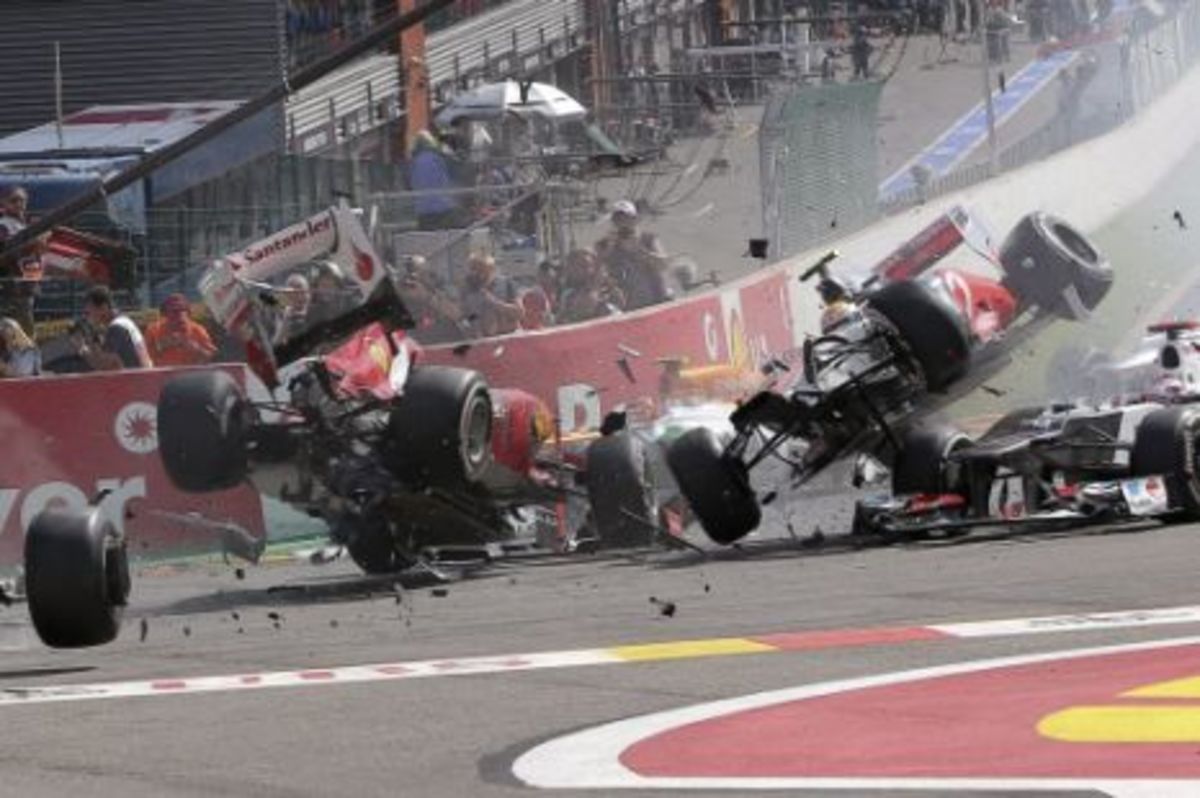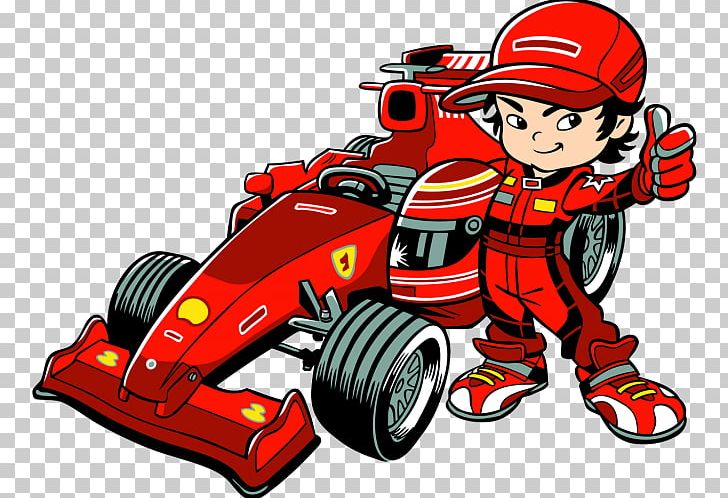Are we going to downplay what drivers do by equating it to a few hours or sweat and a marketing commitment, seriously feel free to put your life at risk for the entertainment of other human beings and then don't expect to get paid. F1 has 20 seats, some people die before they even get a chance at formula 1, because even formula 2 is just as dangerous, the level of skill required here is 1 in hundreds of millions. So yes these drivers deserve every penny and maybe more, because none of these drivers should risking their lives for your amusement without being properly compensated. $1M is way to low, I agree with focusing more on race placements maybe to control salaries, but a base salary I think is a must. Athletes are not slaves that has to give up they lives and time and devote everything for our enjoyment. The moment salaries are reduced in sports, racing and all these things revert to slavery.
Because I can guarantee you would not devote all what you need to become good at any sport and expect minimum wage. That would be like me saying journalism is just a bunch of words put together in a few minutes or photographers are pointless because all you do is press a button. Stop reducing persons skill to just what you see on paper, when there is so much that goes on behind the scenes. These people are human beings, not your puppets that you have at your beckon call. Empathy is not something that has to be learnt through experience, empathy is something we should have naturally and is disappointing that we as a human race cannot grasp that or relate to something unless we experience that hard ship oursolves. With few Formula 1 driver salaries publicly available, Forbes relied on financial documents, legal filings and press leaks as well as conversations with industry insiders and consultants to compile this list.
Drivers typically receive a base salary plus bonuses for points scored or for race or championship wins, with the amount depending on the size of the team and the experience of the driver. Lewis Hamilton, who replaced Michael Schumacher at Mercedes in 2012, has become an icon on the same level as his predecessor. Last year, Hamilton matched Schumacher's record with his seventh F1 drivers' championship, and he has dominated the competition with his earnings the way that Schumacher, the world's highest-paid athlete in 2000 and 2001, once did. The 36-year-old signed a two-year contract extension with Mercedes this summer, following up on a three-year, $140 million deal in 2015 and a two-year, $100 million extension in 2018. He is also the founder of X44, a team in the new off-road electric-SUV racing series Extreme E.
Leading the pack is Mercedes superstar Lewis Hamilton, who is on pace to earn $62 million on the track in 2021. That figure includes a $55 million base salary—more than double what his closest competitor is guaranteed—as well as a projected $7 million in bonuses for race wins. NFL has hardly any interest outside of the US, despite numerous attempts to spread it to Europe. Whereas F1, football, tennis, etc, are played and watched around the globe. The stars of those sports are known world wide and earn accordingly. There are only 20 F1 drivers, there are hundreds of NFL players and I couldn't name one.
There's no games for retired players, there are no games for anyone who doesn't play at college and then become a professional. Beginning in this season, F1 teams are subject to a cost cap of $175 million per team. This cap limits expenditures on car performance but doesn't apply to marketing costs or driver salaries. "The aim is to deliver a more competitive championship that features a more level playing field, while ensuring the drive for creating unique and boundary-breaking technology and engineering remains," Formula 1 explains on its website.
Lewis Hamilton called the 2021 season the hardest ever in his 15 years at the pinnacle of motorsport. The drivers were at the top of the game, their respective Mercedes and Red Bull Racing teams were the class of the field. The intense rivalry between the 36-year-old seven-time world champion Englishman and his hard-charging 24-year-old Dutch rival was marred by frequent clashes.
Responding to Verstappen's aggressive driving, Hamilton fought back in kind - setting them on a collision course seemingly destined to end in controversy – which it did. Millions of enthralled viewers witnessed one the most ferociously fought championships in F1 history. Although occasionally pay drivers are labelled as "unworthy" for an F1 seat, many of the pay drivers in F1 today come with occasional success in their individual races in lower formulas. Maldonado would cement his place in Formula One history with a win at the 2012 Spanish Grand Prix as the first Venezuelan to win in F1 with what became the only pole, podium, and win of his career. It was also the first win for Williams since 2004 and their last as of 2021. F3 drivers are not paid for racing at the lower levels, but they can earn money through personal sponsorships.
F3 racers must pay a team to give them their seat in a race. Affiliating with a team can help them make money by appearing in promotional activities representing the team, whether it be through public appearances or through media and advertisements. There are many methods for F3 racers to promote their racing careers while also earning money for doing so. Although DTM drivers are paid for their races, they are not paid very much.
There is no official list of the salaries of DTM drivers, like there are for F1 or NASCAR racers, but the salaries of the top DTM drivers are believed to be similar to those of V8 Supercar Drivers in Australia. The top racers in Australia's racing league are paid as high as $1 million per year. However, this only applies to the top racers, so most racers in the DTM likely make a salary that can be significantly lower than that figure.
In most professional and minor league sports, athletes are paid for their work and contributions to their team. Most F3 drivers will have to pay the teams in order to secure their spot in races for a season. Racers are not paid for their performances, but instead can only make money through personal sponsorships.
Success in F3 can lead to a spot in F2 or even a direct advancement to F1, although this is very rare. Leading the field is Lewis Hamilton (Mercedes-AMG), with a reported annual salary of $30 million. At the end of the 2020 season, Hamilton was reportedly earning around $40m per year, but his new deal (a one-year contract with the option to extend into 2022) saw him take a reduced salary.
Despite him being a seven-time champion and rewriting the sport's record books, it wasn't enough to warrant a hefty paycheck. And with Williams driver George Russell waiting in the wings to take over, Hamilton had little choice but to agree to the new deal. Hamilton, who has four wins through ten races, still has time to overtake Verstappen, with the gap in the standings a mere eight points and 12 races remaining on the schedule .
In 2014, when major regulation changes featured new hybrid power units in chassis with reduced downforce, Mercedes dominated the season, winning 16 of the 19 races and easily securing the Constructors' Championship. Mercedes' policy of letting its drivers race each other enabled team mates Lewis Hamilton and Nico Rosberg to engage in an enthralling season-long duel for the driving title. Adding extra human interest to the drama was the fact that Hamilton and Rosberg had been friends and rivals since their karting days as teenagers. Now, as 29-year-old protagonists competing for honours at the pinnacle of motorsport, the intensity of their rivalry strained their friendship and tested their strength of character. At number 2 in the highest-paid race car drivers is Fernando Alonso.
He first got behind the steering wheel when he was three and got into kart racing and won three consecutive championships. He enjoyed a period of unprecedented success when he won four F1 World Driver Championships consecutively. This made him the only fourth person to ever win four or more championships. He has earned a reported $32 million last year making him one of the top paid race car drivers.
One of these leagues is the DTM, or the Deutsche Tourenwagen Masters . Although a majority of the racers in this league are not paid handsomely, it can be viewed as a better alternative than F3 simply because the racers are paid for their performance. There is some controversy regarding the F3 salary structure, as it can be worrisome for some younger races who do not have a well-off family to support their racing endeavours.
These racers may also not attract sponsorships from teams because their financial situations may not compare favorably to other F3 racers. Some drivers attempt to pursue the start of their racing careers in other lower level racing leagues, where they will be paid directly for their races. Being paid an estimated $40-$50 million to drive an F1 race car is clearly outrageous, especially considering that winning an F1 race is not solely nor mostly dependent on the driver. Consider the fraction of Hamilton's yearly salary that Bottas gets, and Bottas still gets some wins, the disparity between those two drivers, on the same team, is quite ridiculous. The difference in salary is a factor in how the team mates view each other, and that affects the racing. True, some drivers pay to race, but that compounds the divide between the top three teams and the rest.
Formula 1 Race Car Drivers The solution is for driver earnings to be included in budget caps on the basis that they are performance differentiators, which would in turn release more funding for staff and technology by driving down driver costs. On a wet to drying track wheel-to-wheel battles raged throughout the field, beginning with Hamilton pushing aside his polesitting Mercedes team mate Nico Rosberg on the opening lap. Many driving errors were made but Hamilton never put a wheel wrong in winning his 10th race of the year - an historic 43rd career victory that vaulted him into third place in the all-time winners list behind Michael Schumacher and Alain Prost. There are also "perks." Some drivers' contracts will include a motorhome as well as expenses (fuel, cleaning, etc.) to maintain it. Team and now series owner Roger Penske has been known to "take care of" his veteran drivers in lieu of paying them premium salaries, one source said. That can mean any number of things, but includes helping set up his drivers with car dealerships or making other business arrangements where they can earn money away from the track.
If they win one race, they get X dollars; if they win two, double it. If they win the Indianapolis 500, that's usually where the biggest bonus comes — even more so than winning the series championship. Sometimes, that bonus will come from the team, but it often comes from a team partner or sponsor. As a hypothetical, if Scott Dixon won the 105th running of the Indianapolis 500 this year, PNC Bank might pay him a bonus as a reward for all of the added exposure. Just like NASCAR racing Formula one also offered pit crew services for drivers and teams. Millions of dollars paid to the pit crew staff's each year for their efforts during the race.
F1 Pit Crew Members Salaries reported in year 2015 for the first time. Pay drivers are also common in stock car racing and are very prevalent in development series such as the Xfinity Series and ARCA Racing Series. There are also several pay drivers competing at the Cup level including Matt Tifft and Paul Menard, the son of home improvement tycoon John. Menard had some success with a victory at the Brickyard 400 in 2011 and a Chase for the Sprint Cup appearance in 2015, while medical issues halted Tifft's racing career in 2019. At one time F1 regulations regarding the changing of drivers during the course of a season were extremely liberal, which encouraged some teams to recruit a string of pay drivers to drive their cars, sometimes only for one or two races.
Because of this the rules on driver changes were subsequently tightened. A pay driver is a driver for a professional auto racing team who, instead of being paid by the owner of their car, drives for free and brings with them either personal sponsorship or personal or family funding to finance the team's operations. This may be done to gain on-track experience or to live the lifestyle of a driver in a particular series when one's talent or credentials do not merit a paying ride. Alternatively, said person is also called a ride buyer or a rich kid in the United States, a gentleman driver in sports car and GT racing and a privateer in Australia. Car Racing is one of the most taxing and at the same time one of the most lucrative sports in the world.
Not only are race car drivers crazy famous but are also paid mullah. Here we take a look at thetop 10 highest paid race car drivers. It's unclear what will happen with driver salaries next year under the budget cap, though despite their earnings are exempt, it may indicate an overall levelling out of money earned by the drivers at the top of the grid. However, it is likely that as long as Hamilton remains in F1, he will secure his place at the top of this particular list.
In LMP3, and frankly every class and series on the planet, there are outliers who make less or more than the majority of the paid drivers. For the grand season opener at Daytona where some higher-profile drivers might be added to the 24-hour roster, receiving a check for "$20,000, maybe up to $25,000" was suggested as a solid payday. Among the outliers, a very small percentage of pros in LMP3 are known to be close to or slightly over $200,000 for a season, according to someone with intimate knowledge of the rates being paid. If you are a Formula 1 fan, then it's not surprising that F1 legend Lewis Hamilton is the highest-paid Formula 1 driver right now.
The world champion Hamilton making $65 million from his deal with Mercedes while his rival Max Verstappen earn around $23.5 million with Red Bull, and Aston Martin driver Sebastian Vettel is now far behind with reported earnings of $23 million. 2021 has witnessed a few contract extension and increment in the F1 driver salaries. It is expected that Charles Leclerc and Valtteri Bottas will enjoy considerable growth in their 2021 salaries.
However, their contract provides them with substantial performance-based bonuses. Pierre Gasly is reported to earn a bonus double his base salary after his first Grand Prix win this season. Unlike most professional sports in the United States, where agents and even teams regularly release contract figures, Formula 1 is still a rather closed society in that regard and actual figures are not released.
In F1, drivers typically work for a base salary plus bonuses for wins and place in the final standings. How much an F1 driver, or any athlete in any sport, gets paid should be based on how much the team owner/s and the athlete can negotiate and agree. Only the person/company how much any athlete is worth to their team. That said, as an organization, like any sport, F1 could and should consider the great disparity of salary between drivers in each team. I base that on the prevailing thinking that any employee should be paid an equal salary for equal work requirements. As with any job, every employee is expected to "produce" for the company.
In racing the product of the driver/employee is race position outcome, along with meeting the other work requirements of testing, media appearances, and any other agreed to work requirements. Because there is also a salary floor, teams at the bottom of the series can exploit that because of quirks that mean that teams have to pay the salaries of injured players. After two years away from the F1 track, Fernando Alonso is back with Alpine. The 39-year-old, once at the center of the series' Spygate and Crashgate scandals, has rebuilt himself into a tremendously popular driver, in part by broadening his auto-racing horizons. In recent years, he has competed in the Indianapolis 500, entered the Dakar Rally and won the endurance races 24 Hours of Le Mans and 24 Hours of Daytona.
The Spaniard won the drivers' championship in 2005 and 2006 with Renault—an earlier incarnation of his current team. Most of the contracts of Formula 1 drivers include performance-based bonuses wherein they will get an amount based on winning a race and also scoring points over and above the threshold level agreed mutually. Most F1 drivers do not boast about their earnings however they don't stop the press from speculating either. F1 drivers have huge salaries, as well as payouts from sponsorship deals and advertising. Lewis Hamilton is dominating the salary leaderboard - earning up to 60 times more than other drivers - a chart has revealed.
Full list of 2021 contract deals, including for Max Verstappen, Daniel Ricciardo, and George Russell. While the family's financial struggle was over it put extra pressure on McLaren's teenage protege to meet ever higher expectations. As well as having to respond to envious critics who claimed he should be winning all the time, given his funding, it was imperative that Lewis continually prove himself worthy of his benefactor's investment. The need to achieve undoubtedly accelerated his progress through motorsport's ranks. After winning eight championships in six years of kart racing, he went on to win three major single seater titles, the most prestigious of which was the GP2 championship, where in 2006 he took five victories from 21 starts.
But it was the young British charger's several spirited comeback performances, from the back of the pack to the podium, that particularly prompted McLaren to promote him to the Formula One team. Winning a competition will lead to earning the competition's purse money which is the primary source of income for racecar drivers racing full time. Some sanctioning bodies will offer champions of lower tier series a well-funded ride for the next tier. The Road to Indy programme from INDYCAR awards a ride fully funded by Mazda for a series champion in the next tier.
A $150,000 and tires package is available to a shootout winner among an invited group young American and foreign drivers. F2000 National Championship will win $300,000 to be used for a "pay ride" in the Pro Mazda Championship, and two sets of tires per race. Pro Mazda winners will be paid for a ride in Indy Lights, and the Indy Lights champion earns funding to compete in at least three IndyCar Series races, including the Indianapolis 500. He earned approximately $23.5 million combining both his winnings and endorsements and with a net worth of $300 million, he really is one of the richest race car drivers in the world. Drivers are not paid in F3, but they can gain valuable exposure and recognition for their performance if they do well. Better performance can attract lucrative sponsorships from teams who are more renowned, and can also help a young F3 driver reach the F1 faster.



























No comments:
Post a Comment
Note: Only a member of this blog may post a comment.